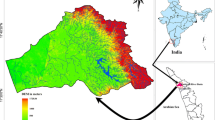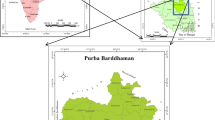Abstract
The importance of groundwater potential zone (GWPZ) is a vital aspect for the society as directly or indirectly it sustains and supports the urban, crop irrigation and industrial activities. This study involves multi-parametric comparative geospatial modelling for delineation of potential groundwater zones. The Remote Sensing based and supplementary data were processed in the GIS environment to obtain the raster/vector layers of various themes such as land-slope, litho-units, stream density, lineaments, surface run off and land utilization. The thematic layers thus derived were subsequently divided into sub-criterion and suitable weights were assigned according to the degree of influence on groundwater dynamics using multi-parametric evaluation methods namely Multi-Criteria Decision Making (MCDM) and Multi-Influencing Factors (MIF). Furthermore, the outputs of both the techniques are superimposed to delineate more precise delineation of GWPZ in the study area. The validation of results reveal that the MCDM technique output map has total 160 wells i.e. around 96% falling in good—excellent zones. Whereas, MIF technique predicted 137 wells (about 83%) covering the same range, while the combination of both the techniques revealed 148 wells out of 166 wells (89%) falling in favourable zones.
Access this chapter
Tax calculation will be finalised at checkout
Purchases are for personal use only
Similar content being viewed by others
References
Adhikary, P. P., Chandrasekharan, H., Chakraborty, D., & Kamble, K. (2010). Assessment of groundwater pollution in west Delhi, India using geostatistical approach. Environmental Monitoring and Assessment, 167, 599–615.
Adji, T. N., & Sejati, S. P. (2014). Identification of groundwater potential zones within an area with various geomorphological units by using several field parameters and a GIS approach in KulonProgo Regency, Java. Indonesia. Arabian Journal Geoscience, 7(1), 161–172.
Balamurugan, G., Seshan, K., & Bera, S. (2017). Frequency ratio model for groundwater potential mapping and its sustainable management in cold desert. India. Journal King Saud University Science, 29(3), 333–347.
Bali, R., Agarwal, K., Nawaz, A. S., Rastogi, S., & Krishna, K. (2012). Drainage morphometry of Himalayan Glacio-fluvial basin, India: hydrologic and neotectonic implications. Environment Earth Science, 66(4), 1163–1174.
Ballukraya, P., & Kalimuthu, R. (2010). Quantitative hydrogeological and geomorphological analyses for groundwater potential assessment in hard rock terrains. Current Science, 98(2), 253–259.
Bhattacharyya, T., Pal, D. K., Mandal, C., Chandran, C., Ray, S. K., et al. (2013). Soils of India: historical perspective, classification and recent advances. Current Science, 104(10), 1308–1323.
CGWB. (2011). Dynamic groundwater resources of India. Ministry of Water Resources, Government of India, New Delhi: Central Ground Water Board.
Chandio, I. A., Matori, A. N. B., WanYusof, K. B., Talpur, M. A. H., Balogun, A. L., & Lawal, D. U. (2013). GIS-based analytic hierarchy process as a multicriteria decision analysis instrument: A review. Arabian Journal of Geosciences , 6(8), 3059–3066.
Chenini, I., & Mammou, A. B. (2010). Groundwater recharge study in arid region: An approach using GIS techniques and numerical modeling. Computer Geology Science, 36(6), 801–817.
Chowdhury, A., Jha, M. K., Chowdary, V. M., & Mal, B. C. P. (2009). Integrated remote sensing and GIS based approach for accessing ground- water potential in West Medinipur district, West Bengal. India. International Journal Remote Sensing, 30(1), 231–250.
Deepa, S., Venkateswaran, S., Ayyandurai, R., Kannan, R., & Prabhu, M. J. (2016). Groundwater recharge potential zones mapping in upper Manimuktha sub basin Vellar River Tamil Nadu India using GIS and remote sensing techniques. Model Earth System Environment, 2, 137.
Doell, P., Schmied, H. M., Schuh, C., Portmann, F. T., & Eicker, A. (2014). Global-scale assessment of groundwater depletion and related groundwater abstractions: combining hydrological modeling with information from well observations and GRACE satellites. Water Resources Research, 50, 5698–5720.
Golkarian, A., & Rahmati, O. (2018). Use of a maximum entropy model to identify the key factors that influence groundwater availability on the Gonabad Plain. Iranian Environment Earth Science, 77, 369.
Gumma, M. K., & Pavelic, P. (2012). Mapping of groundwater potential zones across Ghana using remote sensing, geographic information systems, and spatial modeling. Environmental Monitoring and Assessment, 185(4), 3561–3579.
Horton, R. E. (1932). Drainage basin characteristics. Transactions American Geophysics Union, 13, 350–361.
Jasrotia, A. S., Bhagat, B. D., Kumar, A., & Kumar, R. (2013). Remote sensing and GIS approach for delineation of groundwater potential and groundwater quality zones of Western Doon Valley, Uttarakhand. India. Journal of Indian Society Remote Sensing, 41(2), 365–377.
Jenifer, M. A., & Jha, M. K. (2017). Comparison of analytic hierarchy process, catastrophe and entropy techniques for evaluating groundwater prospect of hard-rock aquifer systems. Journal of Hydrology (Amst), 548, 605–624.
Jha, M. K., Chowdary, V. M., Kulkarni, Y., & Mal, B. C. (2014). Rainwater harvesting planning using geospatial techniques and multicriteria decision analysis. Resource Conservation Recycling, 83, 96–111.
Kadam, A. K. (2018). Hydrological response-based watershed prioritization in semiarid, basaltic region of western India using frequency ratio, fuzzy logic and AHP method. Environment Development and Sustainability, 21(4), 1:25.
Kaliraj, S., Chandrasekar, N., & Magesh, N. S. (2014). Identification of potential groundwater recharge zones in Vaigai upper watershed, Tamil Nadu, using GIS-based analytical hierarchical process (AHP) technique. Arabian Journal of Geosciences , 7(4), 1385–1401.
Kumar, A., & Krishna, A. P. (2018). Assessment of groundwater potential zones in coal mining impacted hard-rock terrain of India by integrating geospatial and analytic hierarchy process (AHP) approach. Geocarto International, 33(2), 105–129.
Li, P., He, S., Yang, N., & Xiang, G. (2018). Groundwater quality assessment for domestic and agricultural purposes in Yan’an City, Northwest China: Implications to sustainable groundwater quality management on the Loess Plateau. Environment Earth Science, 77(23), 775.
Machiwal, D., Madan, K., Jha, M. K., Bimal, C., & Mal, B. C. (2011). Assessment of groundwater potential in a semi-arid region of India using remote sensing, GIS and MCDM techniques. Water Resource Management, 25(5), 1359–1386.
Magesh, N. S., Chandrasekar, N., & Soundranayagam, J. P. (2011). Morphometric evaluation of Papanasam and Manimuthar watersheds, parts of Western Ghats, Tirunelveli district, Tamil Nadu India: A GIS approach. Environmental Earth Science, 64(2), 373–381.
Magesh, N. S., Chandrasekar, N., & Soundranayagam, J. P. (2012). Delineation of groundwater potential zones in Theni district, Tamil Nadu, using remote sensing. GIS and MIF Techniques. Geoscience Frontiers, 3(2), 189–196.
Malczewski, J. (2006). GIS-based multicriteria decision analysis: A survey of the literature. International Journal of Geographical Information Science, 20(7), 703–726.
Malekmohammadi, B., Mehrian, M. R., & Jafari, H. R. (2012). Site selection for managed aquifer recharge using fuzzy rules: Integrating geographical information system (GIS) tools and multi-criteria decision making. Hydrogeology Journal, 20(7), 1393–1405.
Mishra, S., Tiwary, D., Ohri, A., & Agnihotri, A. K. (2019). Impact of municipal solid waste landfill leachate on groundwater quality in Varanasi. India. Groundwater for Sustainable Development, 9(10), 1002–1030.
Murthy, K. S. R. (2000). Groundwater potential in a semi-arid region of Andhra Pradesh-a geographical information system approach. International Journal of Remote Sensing, 21(9), 1867–1884.
Naghibi, S. A., Pourghasemi, H. R., Pourtaghi, Z. S., & Rezaei, A. (2015). Groundwater qanat potential mapping using frequency ratio and Shannon’s entropy models in the Moghan watershed. Iran. Earth Science India, 8(1), 171–186.
Nampak, H., Pradhan, B., & Manap, M. A. (2014). Application of GIS based data driven evidential belief function model to predict groundwater potential zonation. Journal of Hydrology, 513, 283–300.
Patra, S., Mishra, P., & Mahapatra, S. C. (2017). Delineation of groundwater potential zone for sustainable development: A case study from Ganga Alluvial Plain covering Hooghly district of India using remote sensing, geographic information system and analytic hierarchy process. Journal of Cleaner Production, 172, 2485–2502.
Selvam, S., & Sivasubramanian, P. (2012). Groundwater potential zone identification using geoelectrical survey: A case study from Medak district, Andhra Pradesh, India. International Journal of Geomatics and Geosciences, 3(1), 55–62.
Senanayake, I. P., Dissanayake, D. M. D. O. K., Mayadunna, B. B., & Weerasekera, W. L. (2016). An approach to delineate groundwater recharge potential sites in Ambalantota. Sri Lanka Using GIS Techniques. Geoscience Frontiers, 7(1), 115–124.
Singhai, A., Das, S., Kadam, A. K., et al. (2019). GIS-based multi-criteria approach for identification of rainwater harvesting zones in upper Betwa sub-basin of Madhya Pradesh. India, Environment Development Sustain, 21(2), 777–797.
Thakur, J. K., Thakur, R. K., Ramanathan, A., Kumar, M., & Singh, S. K. (2011). Arsenic contamination of groundwater in Nepal—An overview. Water, 3(1), 1–20.
Thapa, R., Gupta, S., Guin, S., & Kaur, H. (2017). Assessment of groundwater potential zones using multi-influencing factor (MIF) and GIS: A case study from Birbhum district. West Bengal. Applied Water Science, 7(7), 4117–4131.
Umar, R., Ahmed, I., & Alam, F. (2009). Mapping groundwater vulnerable zones using modified DRASTIC approach of an alluvial aquifer in parts of central Ganga plain. Western Uttar Pradesh. Journal Geology Society India, 73(2), 93–201.
White, P. A., Hong, Y. S., Murray, D. L., Scott, D. M., & Thorpe, H. R. (2003). Evaluation of regional models of rainfall recharge to groundwater by comparison with lysimeter measurements, Canterbury. New Zealand. Journal of Hydrology, 42(1), 39–64.
Yeh, H. F., Cheng, Y. S., Lin, H. I., & Lee, C. H. (2016). Mapping groundwater recharge potential zone using a GIS approach in Hualian river. Taiwan. Sustainable Environment Research, 26(1), 33–43.
Author information
Authors and Affiliations
Corresponding author
Editor information
Editors and Affiliations
Rights and permissions
Copyright information
© 2021 Springer Nature Switzerland AG
About this chapter
Cite this chapter
Das, S. et al. (2021). Efficacy of Geospatial Technologies for Groundwater Prospect Zonation in Lower Western Ghats Area of Maharashtra, India. In: Adhikary, P.P., Shit, P.K., Santra, P., Bhunia, G.S., Tiwari, A.K., Chaudhary, B.S. (eds) Geostatistics and Geospatial Technologies for Groundwater Resources in India. Springer Hydrogeology. Springer, Cham. https://doi.org/10.1007/978-3-030-62397-5_6
Download citation
DOI: https://doi.org/10.1007/978-3-030-62397-5_6
Published:
Publisher Name: Springer, Cham
Print ISBN: 978-3-030-62396-8
Online ISBN: 978-3-030-62397-5
eBook Packages: Earth and Environmental ScienceEarth and Environmental Science (R0)




